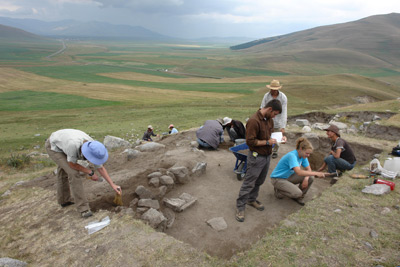Cornell Institute of Archaeology and Material Studies founded
By Linda B. Glaser

A period of explosive growth in archaeology-related teaching and research at Cornell has culminated in the establishment of the new Cornell Institute of Archaeology and Material Studies (CIAMS).
CIAMS will "leverage the interdisciplinary nature of the field today in order to generate the new ideas and collaborations which will lead the field tomorrow," said Sturt Manning, CIAMS director and the Goldwin Smith Professor of Classical Archaeology.
"The 'material studies' part of the CIAMS name reflects a renewed engagement with the material world," Manning explained. "Many of the fundamental challenges of our time -- climate change, social inequality, gun control -- not to mention values we hold regarding aesthetics and behaviors -- all emerge out of centuries and even millennia of human interaction with the vast world of material objects."
The institute includes 18 faculty members and a postdoctoral researcher from five departments (anthropology, classics, history of art, landscape architecture and Near Eastern studies) and two colleges (Arts and Sciences; Agriculture and Life Sciences).
"We have exciting new faculty who make this a perfect moment for reconsidering archaeology as a whole," said Peter Lepage, the Harold Tanner Dean of the College of Arts and Sciences. "And because archaeology exists within the graduate fields and undergraduate departments of multiple disciplines at Cornell, by enhancing archaeology this institute will strengthen these departments as well."
Cornell boasts one of the country's larger concentrations of faculty specializing in classical and Mediterranean archaeology and art, according to Manning. He noted that Cornell is also the only U.S. center for study of the Caucasus with two prominent researchers working in the field. Other strengths at Cornell include Cypriot prehistory, garden archaeology, regional archaeology, Mesoamerica and the historic archaeology of New York and northeastern North America.
The new faculty members have increased the number of active field projects, which now span research in Armenia, Cyprus, Greece, Israel, Italy, Jordan, Turkey, the United States and the Americas (all of which involve student participants). Recent funding for these projects include two National Science Foundation (NSF) grants, a National Endowment for the Humanities grant and a share of a Canadian Social Sciences and Humanities Research Council award. At least three NSF applications have recently been submitted, indicating "a scale of archaeological activity and aspiration never seen before at Cornell," Manning said.
In the last five years, the number of archaeology-related courses at Cornell has doubled. CIAMS will structure these courses into a curriculum critically addressing the role of the past and of objects in shaping our world today, and preparing students for further study or careers in fields ranging from heritage management and museum science to field archaeology, human environments and laboratory analysis of materials.
The undergraduate major and minor in archaeology will continue to be granted through the archaeology program, which has been subsumed under CIAMS. The revamped master's degree program will include a track in archaeology and one in object-oriented and museum studies. Due to the program's improved focus and defined goals, students will now be able to complete a master's degree in 12 to 18 months.
Graduate students in the field of archaeology or working on archaeological topics within other fields (such as anthropology, classics, history of art or Near Eastern studies) can become part of CIAMS by participating in seminar series. Students in good standing with the institute will be eligible to apply for research funding through CIAMS; an annual prize will be given for the best Ph.D. dissertation and master's thesis. As additional funds are raised, the institute plans to expand its support for these and other activities, Manning said.
==========
Graduate archaeology study a growing field
In the past five years, the number of graduate students in the field of archaeology or working on archaeological topics at Cornell has surged, with some already garnering impressive achievements.
Jeffrey Leon, a Ph.D. student in the field of classics, for example, has won a Wenner Gren Foundation Dissertation Fieldwork Grant for his project on Minoan Crete. And Catherine Kearns, also in the field of classics, has won a Fulbright U.S. Student Grant to work on early Iron Age Cyprus at the Cyprus American Archaeological Research Institute in Nicosia, Cyprus.
Eventually the Cornell Institute of Archaeology and Material Studies (CIAMS) hopes to give this growing graduate population a place of their own, CIAMS Director Sturt Manning said.
"The new Landscapes and Objects Laboratory (in McGraw Hall) is a striking success in quickly becoming home to many of our graduate students, but already it's too small for the number of anticipated students next year," Manning said.
==========
Linda B. Glaser is staff writer for the College of Arts and Sciences.
Media Contact
Get Cornell news delivered right to your inbox.
Subscribe